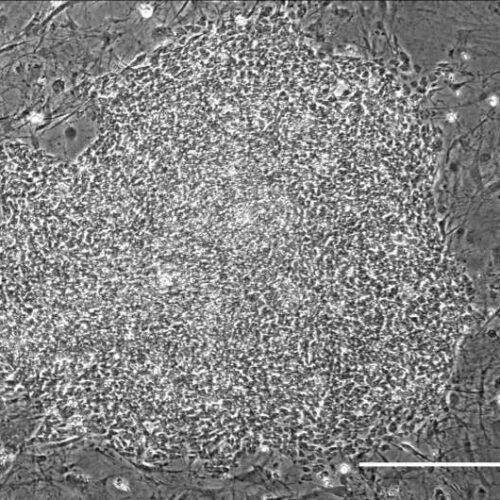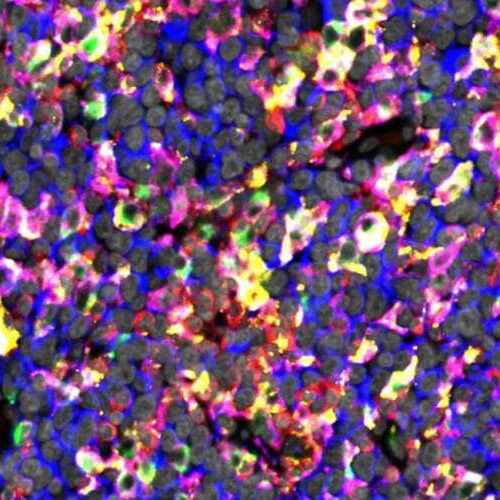MIT biological engineers have developed a simple way to identify B or T cells that interact with viral or bacterial proteins. The human body has millions of unique B and T cells that roam the body, looking for microbial invaders. These immune cells’ ability to recognize harmful microbes is critical to successfully fighting infection. MIT biological engineers...
Tag: <span>Immune cells</span>
Depressive disorders can lead to changes in immune cells
by Dresden University of Technology Real-time deformability cytometry and subsequent AI-based classification of blood cells. Credit: Andreas Walther, CC BY-NC 4.0 Loss of interest, joylessness, lack of drive and increased fatigability—all these complaints are among the main symptoms of depression, a mental illness affecting an estimated 5% of the population in Germany. Pathophysiological features of...
Researchers identify sustainable source of immunodeficiency virus-resistant immune cells
by International Society for Stem Cell Research Monkey iPSCs with edited CCR5 locus growing in culture. Credit: Saritha D’Souza, Wisconsin National Primate Research Center, USA Genetic engineering can make immune cells resistant to infection with human or monkey (simian) immunodeficiency virus (HIV and SIV, respectively). Recently, treatment with HIV-resistant immune cells has given encouraging results...
Uncovering how immune cells nurture brain connections
by Cold Spring Harbor Laboratory In this image of the mouse brain, immune cells known as microglia (white) are seen interacting with other brain cells called chandelier cells (red) and pyramidal neurons (blue). This interaction helps pyramidal neurons grow the right connections during development. Credit: Nicholas Gallo/Van Aelst lab/CSHL, 2022 Microglia, the immune cells of...
Analysis of DNA reveals weapons used by our immune cells to fight tuberculosis
by Agency for Science, Technology and Research (A*STAR), Singapore Fig. 1: Histone acetylome-wide association study of TB. Credit: DOI: 10.1038/s41564-021-01049-w A study led by the Agency for Science, Technology and Research’s (A*STAR) Genome Institute of Singapore (GIS) and Infectious Diseases Labs (ID Labs) has identified a gene, KCNJ15, that is associated with helping our immune...
New research highlights clinical importance of interaction between immune cells in the lymphoma microenvironment
by University of Helsinki The figure shows immunostaining of lymphoma tissue rich in checkpoint proteins expressing macrophages. Credit: University of Helsinki Approximately 700 people are diagnosed with diffuse large B-cell lymphoma (DLBCL) in Finland each year. It is the most common cancer that originates from lymphocytes, immune system cells. Although the disease is treated with...
Immune cells leave fingerprints on tumors metastasized to the brain offering clues to future therapies
UNIVERSITY OF CALIFORNIA SAN FRANCISCO MEDICAL CENTER Using data from over 100,000 malignant and non-malignant cells from 15 human brain metastases, UCSF researchers have revealed two functional archetypes of metastatic cells across 7 different types of brain tumors, each containing both immune and non-immune cell types. Their findings, published the February 17 issue of CELL,...
Gene expression profile allows identification of anti-tumor immune cells for personalized immunotherapy
by National Institutes of Health Workflow for prospective identification of anti-tumor, neoantigen-specific TCRs using NeoTCR signature. Based on single cell gene signature scoring of TIL clusters, we first identify candidate NeoTCR4 and NeoTCR8 cluster populations. Dominant and subdominant clonotypes within the the two candidate NeoTCR clusters are reconstructed and tested against autologous patient tumor mutations,...
New view of lymph nodes shows immune cells in real time
Cornell researchers have for the first time successfully imaged the entire depth of the lymph nodes in a living mouse using three-photon microscopy. The breakthrough technique’s micrometer clarity and noninvasive nature allowed the team to observe the dynamic interactions of immune cells in real time and in an environment that is notoriously dense and difficult...
‘Cell atlas’ of brain vasculature connects stroke with novel immune cells
by University of California, San Francisco Cerebal vascular imaging. Credit: © Michel Royon / Wikimedia Commons, CC BY-SA 3.0 In work that will enhance the study of such diseases as stroke and dementia, researchers at UC San Francisco have cataloged all the cells that form the blood vessels of the human brain, along with their locations...







